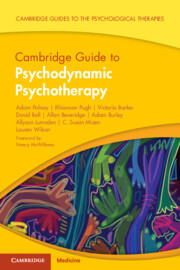Book contents
- Cambridge Guide to Psychodynamic Psychotherapy
- Cambridge Guides to the Psychological Therapies
- Reviews
- Cambridge Guide to Psychodynamic Psychotherapy
- Copyright page
- Dedication
- Contents
- Foreword
- Preface
- A Note from the Series Editor
- Acknowledgements
- Part 1: An Overview of the Model
- Chapter 1 An Historical Overview of Psychodynamic Psychotherapy
- Chapter 2 The Supporting Theory of Psychodynamic Psychotherapy
- Chapter 3 A Brief Description of the Empirical Basis of Psychodynamic Psychotherapy
- Chapter 4 An Outline of Psychodynamic Psychotherapy
- Part 2: The Model of Psychodynamic Psychotherapy into Practice
- Part 3: Application for Mental Health Presentations
- Part 4: Application of Psychodynamic Psychotherapy in Different Populations and in Different Settings
- Glossary of Terms
- Index
- References
Chapter 4 - An Outline of Psychodynamic Psychotherapy
from Part 1: - An Overview of the Model
Published online by Cambridge University Press: 25 August 2023
- Cambridge Guide to Psychodynamic Psychotherapy
- Cambridge Guides to the Psychological Therapies
- Reviews
- Cambridge Guide to Psychodynamic Psychotherapy
- Copyright page
- Dedication
- Contents
- Foreword
- Preface
- A Note from the Series Editor
- Acknowledgements
- Part 1: An Overview of the Model
- Chapter 1 An Historical Overview of Psychodynamic Psychotherapy
- Chapter 2 The Supporting Theory of Psychodynamic Psychotherapy
- Chapter 3 A Brief Description of the Empirical Basis of Psychodynamic Psychotherapy
- Chapter 4 An Outline of Psychodynamic Psychotherapy
- Part 2: The Model of Psychodynamic Psychotherapy into Practice
- Part 3: Application for Mental Health Presentations
- Part 4: Application of Psychodynamic Psychotherapy in Different Populations and in Different Settings
- Glossary of Terms
- Index
- References
Summary
This chapter is a summary of psychodynamic psychotherapy and includes elements of the theory and technique of psychodynamic psychotherapy. It starts with a brief description of what it is and drawing on work by Blagys and Hilsenroth. Seven key features of psychodynamic psychotherapy are described. There is a very brief outline of the various schools of psychotherapy in order to orient the reader. This is followed by brief practical sections explaining the differences between brief and long-term therapy, and between open-ended and closed therapy. Practicalities involved in combining therapy with psychotropic medication are discussed.
- Type
- Chapter
- Information
- Cambridge Guide to Psychodynamic Psychotherapy , pp. 65 - 78Publisher: Cambridge University PressPrint publication year: 2023



